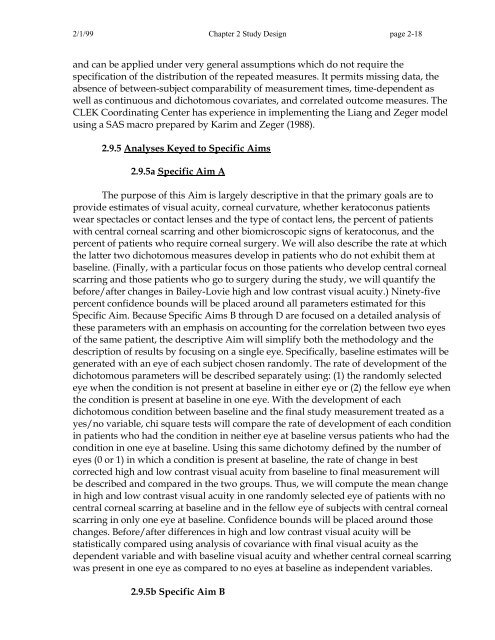OM t of c.iii - Vision Research Coordinating Center - Washington ...
OM t of c.iii - Vision Research Coordinating Center - Washington ...
OM t of c.iii - Vision Research Coordinating Center - Washington ...
You also want an ePaper? Increase the reach of your titles
YUMPU automatically turns print PDFs into web optimized ePapers that Google loves.
2/1/99 Chapter 2 Study Design page 2-18<br />
and can be applied under very general assumptions which do not require the<br />
specification <strong>of</strong> the distribution <strong>of</strong> the repeated measures. It permits missing data, the<br />
absence <strong>of</strong> between-subject comparability <strong>of</strong> measurement times, time-dependent as<br />
well as continuous and dichotomous covariates, and correlated outcome measures. The<br />
CLEK <strong>Coordinating</strong> <strong>Center</strong> has experience in implementing the Liang and Zeger model<br />
using a SAS macro prepared by Karim and Zeger (1988).<br />
2.9.5 Analyses Keyed to Specific Aims<br />
2.9.5a Specific Aim A<br />
The purpose <strong>of</strong> this Aim is largely descriptive in that the primary goals are to<br />
provide estimates <strong>of</strong> visual acuity, corneal curvature, whether keratoconus patients<br />
wear spectacles or contact lenses and the type <strong>of</strong> contact lens, the percent <strong>of</strong> patients<br />
with central corneal scarring and other biomicroscopic signs <strong>of</strong> keratoconus, and the<br />
percent <strong>of</strong> patients who require corneal surgery. We will also describe the rate at which<br />
the latter two dichotomous measures develop in patients who do not exhibit them at<br />
baseline. (Finally, with a particular focus on those patients who develop central corneal<br />
scarring and those patients who go to surgery during the study, we will quantify the<br />
before/after changes in Bailey-Lovie high and low contrast visual acuity.) Ninety-five<br />
percent confidence bounds will be placed around all parameters estimated for this<br />
Specific Aim. Because Specific Aims B through D are focused on a detailed analysis <strong>of</strong><br />
these parameters with an emphasis on accounting for the correlation between two eyes<br />
<strong>of</strong> the same patient, the descriptive Aim will simplify both the methodology and the<br />
description <strong>of</strong> results by focusing on a single eye. Specifically, baseline estimates will be<br />
generated with an eye <strong>of</strong> each subject chosen randomly. The rate <strong>of</strong> development <strong>of</strong> the<br />
dichotomous parameters will be described separately using: (1) the randomly selected<br />
eye when the condition is not present at baseline in either eye or (2) the fellow eye when<br />
the condition is present at baseline in one eye. With the development <strong>of</strong> each<br />
dichotomous condition between baseline and the final study measurement treated as a<br />
yes/no variable, chi square tests will compare the rate <strong>of</strong> development <strong>of</strong> each condition<br />
in patients who had the condition in neither eye at baseline versus patients who had the<br />
condition in one eye at baseline. Using this same dichotomy defined by the number <strong>of</strong><br />
eyes (0 or 1) in which a condition is present at baseline, the rate <strong>of</strong> change in best<br />
corrected high and low contrast visual acuity from baseline to final measurement will<br />
be described and compared in the two groups. Thus, we will compute the mean change<br />
in high and low contrast visual acuity in one randomly selected eye <strong>of</strong> patients with no<br />
central corneal scarring at baseline and in the fellow eye <strong>of</strong> subjects with central corneal<br />
scarring in only one eye at baseline. Confidence bounds will be placed around those<br />
changes. Before/after differences in high and low contrast visual acuity will be<br />
statistically compared using analysis <strong>of</strong> covariance with final visual acuity as the<br />
dependent variable and with baseline visual acuity and whether central corneal scarring<br />
was present in one eye as compared to no eyes at baseline as independent variables.<br />
2.9.5b Specific Aim B
















